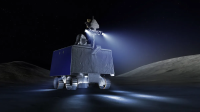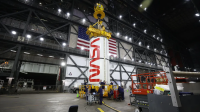A cutting-edge moon lander, Odysseus, has captured its first images from space, showcasing Earth in the backdrop as it embarks on its pioneering mission. Launched atop a SpaceX Falcon 9 rocket on February 15, the robotic spacecraft, developed by Intuitive Machines, transmitted several snapshots shortly after separating from the rocket’s second stage.
“Intuitive Machines successfully transmitted its first IM-1 mission images to Earth on February 16, 2024. The images were captured shortly after separation from @SpaceX’s second stage on Intuitive Machines’ first journey to the moon under @NASA‘s CLPS initiative,” announced the Houston-based company in a post on X, sharing four of the captivating photos.
Under NASA’s Commercial Lunar Payload Services (CLPS) program, Odysseus is carrying six NASA experiments and technology demonstrations, alongside six private payloads, aimed at aiding NASA’s Artemis program. The Artemis initiative endeavors to establish a crewed lunar base near the south pole of the moon by the end of the 2020s.
Intuitive Machines successfully transmitted its first IM-1 mission images to Earth on February 16, 2024. The images were captured shortly after separation from @SpaceX‘s second stage on Intuitive Machines’ first journey to the Moon under @NASA‘s CLPS initiative. pic.twitter.com/9LccL6q5tF
— Intuitive Machines (@Int_Machines) February 17, 2024
This mission marks a significant milestone in private space exploration. “Success on the upcoming landing try would be historic; no private spacecraft has ever touched down softly on the moon,” remarked a spokesperson from Intuitive Machines.
While Odysseus progresses toward its scheduled touchdown attempt on February 22, the spacecraft’s systems, including its engine, are reported to be in optimal condition. The recent commissioning of its liquid methane and liquid oxygen engine in deep space has further bolstered confidence in the mission’s success.
“Intuitive Machines flight controllers successfully fired the first liquid methane and liquid oxygen engine in space, completing the IM-1 mission engine commissioning,” stated the company in a post on X. “This engine firing included a full thrust mainstage engine burn and throttle down-profile necessary to land on the moon.”
Unlike its predecessor, Peregrine, which encountered technical difficulties and had to be steered for controlled destruction in Earth’s atmosphere, Odysseus is on course for a groundbreaking achievement in lunar exploration. With its advanced propulsion system, akin to SpaceX’s Raptor engines, the spacecraft is poised to redefine the possibilities of private space missions, paving the way for future endeavors to the moon and beyond.






